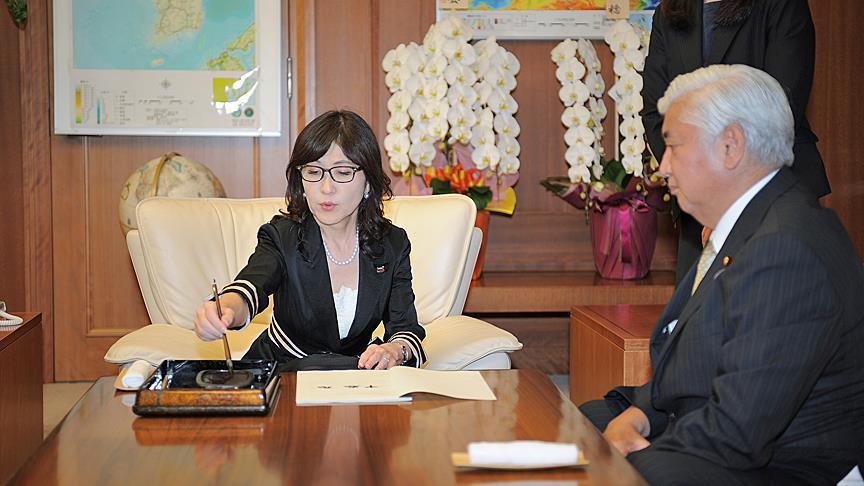Japan: Cabinet reshuffle sees controversial appointment
New defense minister, Tomomi Inada, seen by neighbors to harbor extreme nationalist views, especially relating to World War II issues
 Newly appointed Defense Minister Tomomi Inada (L) and outgoing Defense Minister Gen Nakatani (R) write a message during their handover meeting at the Ministry of Defense in Tokyo, Japan, on August 4, 2016. (David Mareuil - Anadolu Agency)
Newly appointed Defense Minister Tomomi Inada (L) and outgoing Defense Minister Gen Nakatani (R) write a message during their handover meeting at the Ministry of Defense in Tokyo, Japan, on August 4, 2016. (David Mareuil - Anadolu Agency)
By Todd Crowell
TOKYO
Prime Minister Shinzo Abe characterized his cabinet reshuffle this week -- the third in his administration -- as giving a boost to his "biggest priority,” the economy.
But virtually all attention in the press (as well as corridors of power) has since been focused on his decision to appoint Tomomi Inada as minister of defense.
The spotlight has not fallen because Inada is one of the first females to occupy the role (Tokyo’s new female governor also once served a brief turn as defense minister), but because she harbors views seen by neighbors to be extremely nationalist, especially relating to World War II issues.
Inada regularly visits the Yasukuni Shrine, where the spirits of 14 Class A war criminals are enshrined, and also takes issue with the common consensus on the Nanjing massacre of 1937 and maintains that the so-called “comfort women” were not forced into serving in Imperial Army brothels -- as Japan's neighbors see it.
The appointment to such a high profile job is bound to cause some anxiety in China, South Korea and even Washington, which desperately wants Japan and Korea to set aside their historical grievances in order to cooperate more fully in the defense of Northeast Asia.
In 2011, Inada was one of three members of parliament who were denied entry into South Korea while they were attempting to travel to disputed islands that Japan refers to as the Takeshima in the Sea of Japan, which Korea refers to as the East Sea.
The islands, known as Dokdo or Tokto by Korea, lie equidistant from the two mainlands and are believed to contain frozen natural gas deposits potentially worth billions of dollars.
Aside from historical issues, not much is known about her views on defense matters, although she will need to be brought up to speed fairly quickly as potential conflicts are emerging almost weekly.
On the day the reshuffle was announced, for example, North Korea fired off a ballistic missile, which reportedly landed on the Japan side of the Sea of Japan/East Sea.
Okinawa -- the home of U.S. military bases, of which protesters are currently calling for a review -- also provides tricky issues although another minister is in charge of base relocation.
Many political observers in Japan believe that Abe is grooming Inada to be his successor (and the first female prime minister). He has appointed her to key government and party posts and now defense minister. Her last role was as party policy chief.
Meanwhile, other politicians are weighing up a move to the prime minister's office. One such, Shigeru Ishiba, formerly the minister in charge of regional revitalization and a one-tie defense minister, declined to rejoin the cabinet.
Generally considered a serious future rival to Abe, Ishiba said he wants to be free to criticize the government, something he could not easily do if he were bound by cabinet decisions.
Abe is moving toward retirement in September 2018. He is not constitutionally required to step down as premier, but is term-limited as president of the Liberal Democratic Party, a prerequisite for being premier.
Wednesday's cabinet reshuffle also saw the prime minister retain most of his senior colleagues, including Finance Minister Taro Aso, Foreign Minister Fumio Kishida and the chief cabinet secretary and principal government spokesman Yoshihide Suga.
Most of the other portfolios were extended to long-serving members of parliament who want to cap their parliamentary career by becoming cabinet ministers.
"Therefore, many well-known global media, publishers, and government offices use 'East Sea’ in parallel with ‘Sea of Japan’."








